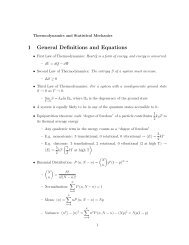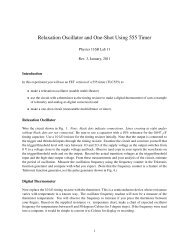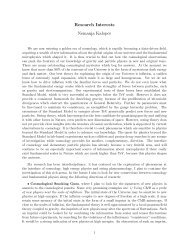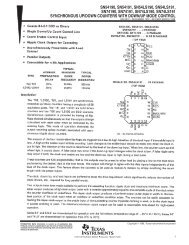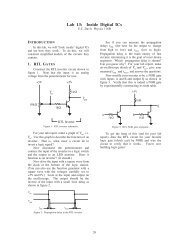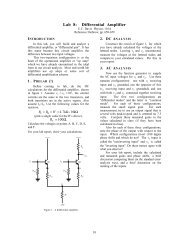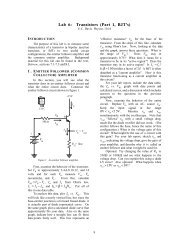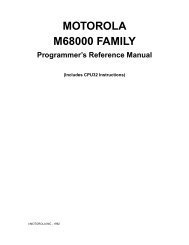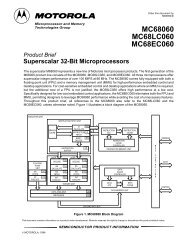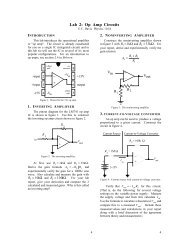M68000 Microprocessor User's Manual
M68000 Microprocessor User's Manual
M68000 Microprocessor User's Manual
Create successful ePaper yourself
Turn your PDF publications into a flip-book with our unique Google optimized e-Paper software.
Bus Request (BR).<br />
This input can be wire-ORed with bus request signals from all other devices that could<br />
be bus masters. This signal indicates to the processor that some other device needs to<br />
become the bus master. Bus requests can be issued at any time during a cycle or<br />
between cycles.<br />
Bus Grant (BG).<br />
This output signal indicates to all other potential bus master devices that the processor<br />
will relinquish bus control at the end of the current bus cycle.<br />
Bus Grant Acknowledge (BGACK).<br />
This input indicates that some other device has become the bus master. This signal<br />
should not be asserted until the following conditions are met:<br />
1. A bus grant has been received.<br />
2. Address strobe is inactive, which indicates that the microprocessor is not using the<br />
bus.<br />
3. Data transfer acknowledge is inactive, which indicates that neither memory nor<br />
peripherals are using the bus.<br />
4. Bus grant acknowledge is inactive, which indicates that no other device is still<br />
claiming bus mastership.<br />
The 48-pin version of the MC68008 has no pin available for the bus grant acknowledge<br />
signal and uses a two-wire bus arbitration scheme instead. If another device in a system<br />
supplies a bus grant acknowledge signal, the bus request input signal to the processor<br />
should be asserted when either the bus request or the bus grant acknowledge from that<br />
device is asserted.<br />
3.5 INTERRUPT CONTROL (IPL0, IPL1, IPL2)<br />
These input signals indicate the encoded priority level of the device requesting an<br />
interrupt. Level seven, which cannot be masked, has the highest priority; level zero<br />
indicates that no interrupts are requested. IPL0 is the least significant bit of the encoded<br />
level, and IPL2 is the most significant bit. For each interrupt request, these signals must<br />
remain asserted until the processor signals interrupt acknowledge (FC2–FC0 and A19–<br />
A16 high) for that request to ensure that the interrupt is recognized.<br />
NOTE<br />
The 48-pin version of the MC68008 has only two interrupt<br />
control signals: IPL0/IPL2 and IPL1. IPL0/IPL2 is internally<br />
connected to both IPL0 and IPL2, which provides four interrupt<br />
priority levels: levels 0, 2, 5, and 7. In all other respects, the<br />
interrupt priority levels in this version of the MC68008 are<br />
identical to those levels in the other microprocessors described<br />
in this manual.<br />
3- 6 <strong>M68000</strong> 8-/16-/32-BIT MICROPROCESSORS USER'S MANUAL MOTOROLA



